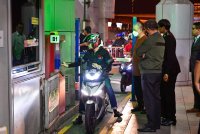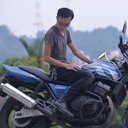
Johor to trial QR code immigration clearance from Jun 1, starting with Malaysians travelling by bus and motorbike
Malaysians on buses at both land checkpoints, as well as motorcyclists at the Kompleks Sultan Abu Bakar connected to the Tuas Second Link, may use QR codes for immigration clearance.

Malaysia's deputy prime minister Fadillah Yusof (in white mask) observing commuters in a surprise visit to Bangunan Sultan Iskandar on May 27, 2024. (Photo: Facebook/Kementerian Dalam Negeri)
JOHOR BAHRU: Malaysians travelling by bus or motorcycle through Johor’s land checkpoints will be able to clear immigration using QR codes from Saturday (Jun 1).
This applies to Malaysia citizens on buses at both land checkpoints connected to Singapore, as well as Malaysian motorcyclists going through Kompleks Sultan Abu Bakar (KSAB) connected to the Tuas Second Link.
Instead of using their passports, they may use QR codes generated via the MySejahtera or MyDigital ID mobile applications to clear immigration.
Deputy Prime Minister Fadillah Yusof made the announcement on Monday (May 27) in Johor Bahru after chairing a special inter-agency meeting on the Johor Causeway and Second Link congestion issue.
A Johor immigration department spokesperson told CNA that motorcyclists at KSAB will be able to scan their QR codes via the M-bike lanes, while bus passengers may do so at designated immigration counters at the Causeway-linked Bangunan Sultan Iskandar (BSI) and KSAB immigration halls.
There are plans to include Malaysian motorcyclists passing through BSI in the pilot initiative, the spokesperson added.
The latest update expands the number of users who may participate in the pilot run – the authorities earlier announced that only Malaysians travelling on factory buses would be involved.
Mr Fadillah said the pilot initiative would last for three months before it could be expanded to Malaysian private vehicle users in phase two. In phase three, Singaporeans and other foreigners would be able to use QR codes for immigration clearance, he said.
Malaysia’s scheme, spearheaded by its Ministry of Home Affairs, follows a successful rollout by Singapore’s Immigration and Checkpoints Authority (ICA) from Mar 19 for those travelling by car on its side of the land border.
 Feedback from commuters has been largely positive since Singapore rolled out QR immigration clearance in March. (Photo: ICA)
Feedback from commuters has been largely positive since Singapore rolled out QR immigration clearance in March. (Photo: ICA)
Many commuters said QR codes helped cut their travel times significantly, shaving 30 minutes off a journey that previously took 90 minutes, for instance.
Malaysia aims to achieve similar outcomes. "The implementation of this QR code will reduce the peak hour waiting time for BSI bus users from 120 minutes to 15 minutes,” said Mr Fadillah.
He added that the waiting time for passengers at KSAB will be reduced from 90 minutes to 15 minutes.
As for motorcyclists, the waiting time at KSAB may be reduced from 45 minutes to 30 minutes with QR code clearance, he said.
Article Credits: CNA
.png.f357c4bbda45b8d1f0301390a48a7ff4.png)
.thumb.jpg.942d9c8d2090d78b3319f3cc3d3744e6.jpg)



Recommended Comments
There are no comments to display.
Join the conversation
You can post now and register later. If you have an account, sign in now to post with your account.